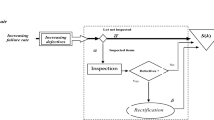Abstract
The advance of new generation of IT and sensor technologies results in data enriched production environment. However, there is a lack of an effective utilization of the data to improve productivity while reducing quality management cost. Therefore, this paper proposes a systematic method to analyze the production dynamics, and presents an event-based method to quantitatively evaluate the impact of various disruptions on system throughput, including machine breakdown and quality failure. It is proved that the impact of the events can be measured with system loss which is the summation of the production loss of the slowest machine and the overall number of defective parts produced in the subsystem where the slowest machine locates in. The data-driven method is integrated into an optimization method to exploit the optimal quality inspection allocations. In the method, a non-linear optimization problem is formulated and solved with an adaptive genetic algorithm to trade off the penalty cost of production loss and the investment cost of quality inspection. The research results in a comprehensive understanding of production dynamics subject to quality inspection and rework. It is of critical importance to boost productivity with better quality inspection allocations. Simulation studies are performed to validate the proposed methods.







Similar content being viewed by others
Change history
09 September 2021
A Correction to this paper has been published: https://doi.org/10.1007/s10845-021-01833-9
Abbreviations
- \(L_{h}\) :
-
The \(h{\text{th}}\) subsystem in the production system, \(1 \le h \le N\)
- \(n_{h} \) :
-
The number of machines in the \(h{\text{th}}\) subsystem, \(1 \le h \le N\)
- \(m_{j}^{h} \) :
-
The \(j{\text{th}}\) machine in the \(h{\text{th}}\) subsystem, \(1 \le h \le N, 1 \le j \le n_{h}\)
- \(v_{j}^{h} \) :
-
The rated speed of machine \(m_{j}^{h}\)
- \(v_{j}^{h} \left( t \right)\) :
-
The instantaneous speed of machine \(m_{j}^{h}\) at time \(t\)
- \({\Lambda }_{j}^{h} \left( t \right) \) :
-
The state of machine \(m_{j}^{h}\) at time \(t\)
- \(X_{j}^{h} \left( t \right)\) :
-
The accumulated production count of machine \(m_{j}^{h}\) during \(\left( {0,t} \right]\)
- \(B_{i}^{h}\) :
-
The ith buffer in the hth subsystem, \(1 \le h \le N, 0 \le i \le n_{h}\)
- \(\psi_{i}^{h} \) :
-
The capacity of buffer \(B_{i}^{h}\)
- \(\omega_{i}^{h} \left( t \right)\) :
-
The buffer level of buffer \(B_{i}^{h}\). It is the number of parts in buffer \(B_{i}^{h}\) at time \(t\)
- \(\vec{\vartheta }_{k} = \left( {m_{j}^{h} ,t_{k} ,d_{k} } \right)\) :
-
The kth machine breakdown event
- \(\vec{\Theta } = \left[ {\vec{\vartheta }_{1} , \ldots ,\vec{\vartheta }_{K} } \right] \) :
-
A sequence of breakdown events, \( 0 < t_{1} \le t_{2} \le \ldots \le t_{K}\)
- \(\vec{\varsigma }_{r} = \left( {L_{h} ,t_{r} ,d_{r} } \right)\) :
-
The rth quality failure event
- \(\vec{\sigma } = \left[ { \vec{\varsigma }_{1} , \ldots , \vec{\varsigma }_{R} } \right] \) :
-
A sequence of quality failure events, \( 0 < t_{1} \le t_{2} \le \ldots \le t_{R}\)
- \(\vec{\sigma }^{{h^{*} }} = \left[ {\vec{\varsigma }_{1}^{{h^{*} }} , \ldots , \vec{\varsigma }_{w}^{{h^{*} }} } \right] \) :
-
A set of quality failure events that happen at subsystem \({ }L_{{h^{*} }}\), \(1 \le w \le R\)
References
Bettayeb, B., Brahimi, N., & Lemoine, D. (2018). Integrated dynamic single item lot-sizing and quality inspection planning. International Journal of Production Research, 56(7), 2611–2627.
Chang, Q., Biller, S., & Xiao, G. (2010). Transient analysis of downtimes and bottleneck dynamics in serial manufacturing systems. Journal of Manufacturing Science and Engineering, 132(5), 051015.
Chen, Y. C. (2013). An optimal production and inspection strategy with preventive maintenance error and rework. Journal of Manufacturing Systems, 32(1), 99–106.
Foumani, M., Gunawan, I., & Smith-Miles, K. (2015). Resolution of deadlocks in a robotic cell scheduling problem with post-process inspection system: Avoidance and recovery scenarios. In: IEEE International Conference on Industrial Engineering and Engineering Management, pages: 1107–1111, Bangkok, Thailand.
Foumani, M., Smith-Miles, K., & Gunawan, I. (2017a). Scheduling of two-machine robotic rework cells: In-process, post-process and in-line inspection scenarios. Robotics and Autonomous Systems, 91, 210–225.
Foumani, M., Smith-Miles, K., Gunawan, I., & Moeini, A. (2017b). A framework for stochastic scheduling of two-machine robotic rework cells with in-process inspection system. Computers and Industrial Engineering, 112, 492–502.
Foumani, M., Razeghi, A., & Smith-Miles, K. (2020). Stochastic optimization of two-machine flow shop robotic cells with controllable inspection times: From theory toward practice. Robotics and Computer-Integrated Manufacturing, 61, 101822.
Franceschini, F., Galetto, M., & Maisano, D. (2006). Classification of performance and quality indicators in manufacturing. International Journal of Services and Operations Management, 2(3), 294–311.
Ju, F., Li, J., Xiao, G., Arinez, J., & Deng, W. (2015). Modeling, analysis, and improvement of integrated productivity and quality system in battery manufacturing. IIE Transactions, 47(12), 1313–1328.
Khadem, M., Ali, S. A., & Seifoddini, H. (2008). Efficacy of lean metrics in evaluating the performance of manufacturing systems. International Journal of Industrial Engineering, 15(2), 176–184.
Khayyati, S., & Tan, B. (2020). Data-driven control of a production system by using marking-dependent threshold policy. International Journal of Production Economics, 226, 107607.
Lei, Y., Jia, F., Lin, J., Xing, S., & Ding, S. X. (2016). An intelligent fault diagnosis method using unsupervised feature learning towards mechanical big data. IEEE Transactions on Industrial Electronics, 63(5), 3137–3147.
Li, L., Chang, Q., & Ni, J. (2009). Data driven bottleneck detection of manufacturing systems. International Journal of Production Research, 47(18), 5019–5036.
Li, L., Wu, M., Liu, X., Cheng, Y., & Yu, Y. (2017). The prediction of surface roughness of PCBN turning GH4169 based on adaptive genetic algorithm. Integrated Ferroelectrics, 180(1), 118–132.
Li, X., Zhang, W., & Ding, Q. (2018). A robust intelligent fault diagnosis method for rolling element bearings based on deep distance metric learning. Neurocomputing, 310, 77–95.
Li, X., Jia, X., Yang, Q., & Lee, J. (2020). Quality analysis in metal additive manufacturing with deep learning. Journal of Intelligent Manufacturing, 31, 2003–2017.
Li, Y., Chang, Q., Xiao, G., & Arinez, J. (2015). Data-driven analysis of downtime impacts in parallel production systems. IEEE Transactions on Automation Science and Engineering, 12(4), 1541–1547.
Li, Y., Wang, J. Q., & Chang, Q. (2019). Event-based production control for energy efficiency improvement in sustainable multistage manufacturing systems. Journal of Manufacturing Science and Engineering, 141(2), 021006.
Liu, Q., Zhang, H., Leng, J., & Chen, X. (2019). Digital twin-driven rapid individualised designing of automated flow-shop manufacturing system. International Journal of Production Research, 57(20), 3903–3919.
Modern quality control with SPC. (2018). Solving scrap: Focus on quality management to achieve dramatic savings. Retrieved November 15, 2020, from https://www.qualitymag.com/articles/95104-solving-scrap-focus-on-quality-management-to-achieve-dramatic-savings
Ouzineb, M., Mhada, F. Z., Pellerin, R., & El Hallaoui, I. (2018). Optimal planning of buffer sizes and inspection station positions. Production and Manufacturing Research, 6(1), 90–112.
Radhoui, M., Rezg, N., & Chelbi, A. (2010). Joint quality control and preventive maintenance strategy for imperfect production processes. Journal of Intelligent Manufacturing, 21(2), 205–212.
Rau, H., Chu, Y. H., & Cho, K. H. (2005). Layer modelling for the inspection allocation problem in re-entrant production systems. International Journal of Production Research, 43(17), 3633–3655.
Rezaei-Malek, M., Mohammadi, M., Dantan, J. Y., Siadat, A., & Tavakkoli-Moghaddam, R. (2019). A review on optimisation of part quality inspection planning in a multi-stage manufacturing system. International Journal of Production Research, 57(15–16), 4880–4897.
Sarkar, B., & Saren, S. (2016). Product inspection policy for an imperfect production system with inspection errors and warranty cost. European Journal of Operational Research, 248(1), 263–271.
Shetwan, A. G., Vitanov, V. I., & Tjahjono, B. (2011). Allocation of quality control stations in multistage manufacturing systems. Computers and Industrial Engineering, 60(4), 473–484.
Siemiatkowski, M., & Przybylski, W. (2006). Simulation studies of process flow with in-line part inspection in machining cells. Journal of Materials Processing Technology, 171(1), 27–34.
Söderberg, R., Wärmefjord, K., Carlson, J. S., & Lindkvist, L. (2017). Toward a digital twin for real-time geometry assurance in individualized production. CIRP Annals, 66(1), 137–140.
Srinivas, M., & Patnaik, L. M. (1994). Adaptive probabilities of crossover and mutation in genetic algorithms. IEEE Transactions on Systems, Man, and Cybernetics, 24(4), 656–667.
Tekin, S., & Andradóttir, S. (2020). Inspection location in capacity-constrained lines. Central European Journal of Operations Research, 28, 905–937.
Tsai, W. C., & Wang, C. H. (2011). Economic optimization for an off-line inspection, disposition and rework model. Computers and Industrial Engineering, 61(3), 891–896.
Van Volsem, S., Dullaert, W., & Van Landeghem, H. (2007). An evolutionary algorithm and discrete event simulation for optimizing inspection strategies for multi-stage processes. European Journal of Operational Research, 179(3), 621–633.
Wang, D. (2011). Robust data-driven modeling approach for real-time final product quality prediction in batch process operation. IEEE Transactions on Industrial Informatics, 7(2), 371–377.
Wang, J., Li, J., Arinez, J., & Biller, S. (2013). Quality bottleneck transitions in flexible manufacturing systems with batch productions. IIE Transactions, 45(2), 190–205.
Wuest, T., Irgens, C., & Thoben, K. D. (2014). An approach to monitoring quality in manufacturing using supervised machine learning on product state data. Journal of Intelligent Manufacturing, 25(5), 1167–1180.
Yu, J., & Yin, Y. (2010). Assembly line balancing based on an adaptive genetic algorithm. International Journal of Advanced Manufacturing Technology, 48(1–4), 347–354.
Zhang, W., Li, X., & Ding, Q. (2019). Deep residual learning-based fault diagnosis method for rotating machinery. ISA Transactions, 95, 295–305.
Zhao, F., Xu, X., & Xie, S. Q. (2009). Computer-aided inspection planning—The state of the art. Computers in Industry, 60(7), 453–466.
Zou, J., Chang, Q., Arinez, J., Xiao, G., & Lei, Y. (2017). Dynamic production system diagnosis and prognosis using model-based data-driven method. Expert Systems with Applications, 80, 200–209.
Acknowledgements
The authors are grateful to the editors and anonymous reviewers for their valuable comments, which have significantly improved the quality of this work.
Funding
This work was supported by the National Key R&D Program of China (No. 2019YFB1703800); the National Natural Science Foundation of China (Nos. 52075453 and 71931007); and the Aeronautical Science Foundation of China (No. 2019ZG053001).
Author information
Authors and Affiliations
Corresponding author
Additional information
Publisher's Note
Springer Nature remains neutral with regard to jurisdictional claims in published maps and institutional affiliations.
The original online version of this article was revised: A formula under the header ‘An event-based modelling method’ has been corrected.
Rights and permissions
About this article
Cite this article
Wang, JQ., Song, YL., Cui, PH. et al. A data-driven method for performance analysis and improvement in production systems with quality inspection. J Intell Manuf 34, 455–469 (2023). https://doi.org/10.1007/s10845-021-01780-5
Received:
Accepted:
Published:
Issue Date:
DOI: https://doi.org/10.1007/s10845-021-01780-5




